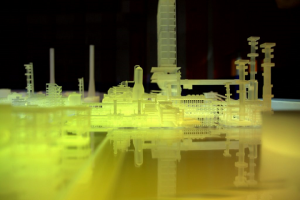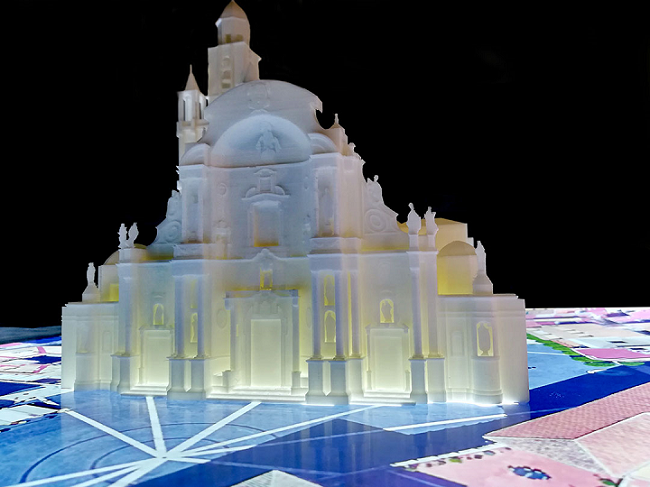More Realistic Models and Prototypes Built with Interactive Technologies such as 3D Printing and Virtual Reality
For visualization of prototypes and infrastructures, models are one of the key factors. A high quality model makes it possible to truly capture a virtual design, along with reducing the scale of the original to make it able to fit on a table, or even in the palm of your hand. Scale models can help designers gain a deeper understanding of all the elements that make up a structure or object, as well as how it works and if there are any flaws in its design.
But, as modern technologies like touchscreens, 3D printing, and video mapping continue to grow, models can now include newer, bolder elements that digitally transform them, making them easier to understand and visualize.
According to a translated quote in an article by TRSD, “It is no longer necessary to manually make all the elements that make up a model since with 3D printing and thanks to the digital models that are more common every day in any work (3D software, BIM models, etc.) we can reproduce in a simple way any element without resorting to complex manufacturing modes.”
For a long time now, traditional models have been meticulously created by hand, which means the model makers are truly closer to artists than simply manufacturers. But model making has continued to evolve over the years, thanks to these newer technologies, into what’s known as interactive models that users are able to…well, interact with more.
Interactive models, which simulate movement through the use of video projection or animations under transparent surfaces, have many advantages.
“They can be programmed with the desired animations or to reproduce real time processes,” I A Manufacturing wrote. “Use your AR/VR device to add movement to your model and a real-time simulation of the environment or the actions that you prefer. Display all the data that you desire in your models to increase your value.”
Models that incorporate these modern technologies are truly the future, and allow designers to expand the possibilities of model making. By adding augmented reality, which Foundry says is an overlay of content on the real world that’s not actually anchored to it, and virtual reality to models, companies like TRSD can give their clients a better understanding of what exactly their real projects will look like once completed. 3D printing gives incredible detail, and adding AR and VR make it possible to change or move objects around with simply the click of a button.
TRSD wrote, “Imagine for a moment that we can place our model on a touch screen that recognizes the elements that we are placing on it and that, depending on the type of object, the screen adapts the displayed image by changing everything around it, for example green areas, roads, services, etc.”
 Many product designers, construction and real estate companies, and architecture and engineering studios are already using interactive models to give their customers more bang for their buck. Another real world example of interactive models is IKEA, which provides an accessible app that allows customers to see how their new furniture will fit in their homes and offices.
Many product designers, construction and real estate companies, and architecture and engineering studios are already using interactive models to give their customers more bang for their buck. Another real world example of interactive models is IKEA, which provides an accessible app that allows customers to see how their new furniture will fit in their homes and offices.
Incorporating additional interactive technologies, such as touchscreens and video mapping, brings us even closer to a new class of interactive models that can be personally adapted to each individual user, which will allow for better communication between manufacturers and clients.
By incorporating technologies like AR, 3D printing, and VR, companies can create models and prototypes that are more interactive and realistic than ever before, while also lowering costs by using digital files and less material, which also helps in reducing waste.
What do you think of this story? Discuss interactive models and other 3D printing topics at 3DPrintBoard.com, or share your thoughts in the Facebook comments below.
[Images: TRSD]Subscribe to Our Email Newsletter
Stay up-to-date on all the latest news from the 3D printing industry and receive information and offers from third party vendors.
You May Also Like
3D Printing Unpeeled: New Arkema Material for HP, Saddle and Macro MEMS
A new Arkema material for MJF is said to reduce costs per part by up to 25% and have an 85% reusability ratio. HP 3D HR PA 12 S has been...
3D Printing News Briefs, January 20, 2024: FDM, LPBF, Underwater 3D Printer, Racing, & More
We’re starting off with a process certification in today’s 3D Printing News Briefs, and then moving on to research about solute trapping, laser powder bed fusion, and then moving on...
3D Printing Webinar and Event Roundup: December 3, 2023
We’ve got plenty of events and webinars coming up for you this week! Quickparts is having a Manufacturing Roadshow, America Makes is holding a Member Town Hall, Stratafest makes two...
Formnext 2023 Day Three: Slam Dunk
I’m high—high on trade show. I’ve met numerous new faces and reconnected with old friends, creating an absolutely wonderful atmosphere. The excitement is palpable over several emerging developments. The high...

































